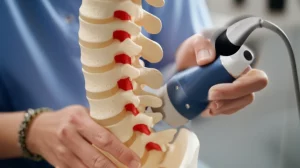Bone Surgery Just Got Safer: Testing a New Burr Tip
Hey There, Let’s Talk About Bone Surgery!
Alright, so picture this: you’re a surgeon, and you need to get to something super important tucked away behind bone. Think of delicate nerves, blood vessels, or that protective layer called the dura in your brain or spine. You need to remove the bone, and fast, but you absolutely, positively cannot nick the stuff underneath. It’s a high-stakes game, right?
For ages, surgeons have relied on high-speed drills with various burr tips to do this job. They’re incredibly effective at chewing through bone. But here’s the catch: they come with risks. We’re talking about accidental damage to the dura, the nerves, the vessels – basically, causing injuries while trying to fix something else. This kind of accidental damage, especially to the dura, can lead to all sorts of headaches down the line: longer hospital stays, more complications, and frankly, higher costs. It’s a real challenge in fields like neurosurgery and spinal surgery.
There are other techniques out there, like ultrasonic bone cutting, which sounds pretty futuristic. And it *is* used in some areas. But even that has shown issues with heat generation and potential injuries. So, the search has been on for a tool that gives you the speed and efficiency of a high-speed drill but with a much-needed safety net.
Enter the Surgify Safety Burr (SSB)
Guess what? Someone’s been working on just that! It’s called the Surgify Safety Burr, or SSB for short. And let me tell you, the core idea is pretty neat. Imagine a burr tip that’s smart enough to know the difference between hard bone and soft, squishy tissue. That’s the magic here.
The SSB has this clever little dynamic shield around the cutting head. When you press it against hard stuff like bone, the shield retracts, and the burr does its job, cutting away. But – and this is the crucial part – if it touches soft tissue, the shield pops out, covering the cutting edges. It basically neutralizes the burr, preventing it from grabbing or damaging the delicate structures underneath the bone. Pretty cool, right?
Not only that, but it’s designed to reduce that annoying and potentially dangerous “chattering” effect you can get with standard burrs – that sudden, uncontrolled jumping. It also apparently slows down automatically when you’re getting close to the end of the bone layer, giving the surgeon extra time to react before hitting soft tissue. Plus, it’s designed to attach to the high-speed drill systems that hospitals already have, which is a big win.
This device is already CE-marked and approved for clinical use in the EU and US, which is a significant step. But before widespread human use, you need to really put it through its paces in a realistic setting.

Putting it to the Test: The Sheep Study
So, how do you test something like this safely and effectively before using it on people? You turn to models that mimic human anatomy and conditions as closely as possible. In this case, researchers used living, anesthetized sheep. Why sheep? Well, their anatomy, especially the skull and spine, is quite suitable for practicing these kinds of surgical procedures. And using *living* animals is key because the pressure from cerebrospinal fluid pushes soft tissues against the bone, just like in a human patient. This makes the test much more realistic for evaluating safety near soft tissues.
The goal of this study was straightforward: see how the SSB stacked up against conventional burrs (specifically diamond and fluted types) when drilling cranial burr holes (holes in the skull) and performing hemilaminectomies (removing part of a spinal bone) in these sheep. They wanted to measure a few key things:
- Did the burr cause any damage to the dura (that protective layer)?
- How long did the drilling take?
- How long did the whole procedure take?
- What was the subjective experience like for the surgeon regarding heating and chattering?
They performed a total of 19 cranial burr holes using the SSB, fluted burrs, and diamond burrs. They also did 14 hemilaminectomies using the SSB and diamond burrs. The surgeons weren’t blinded to which burr they were using (you can tell by looking!), but they carefully recorded all the outcomes.
What We Found: Safety First!
Okay, so here’s the really exciting part, the headline finding: When using the SSB for cranial burr holes, they saw NO penetrating dura damage. Zero. Zip. Nada. This is a huge deal because with the conventional burrs tested – both the fluted and diamond types – they observed penetrating dura damage in a significant number of cases (33% for both!). They also saw superficial dura erosion with the conventional burrs, which wasn’t seen with the SSB.
This difference in dural damage between the SSB and conventional burrs was statistically significant. It really hammered home the safety benefit of the SSB’s protective mechanism.
For the hemilaminectomy procedures, neither the SSB nor the diamond burr caused drilling-induced dura damage. This might suggest that in spinal procedures, where the approach or technique might differ slightly, the risk profile changes, but the SSB still maintained its perfect safety record in this test.
Beyond Safety: Efficiency and Feel
What about speed? The study found that the mean drilling times weren’t significantly different between the SSB and the conventional burrs for either cranial drilling or hemilaminectomy. So, the SSB wasn’t necessarily *slower* despite its safety features.
However, the surgeons had some interesting subjective observations. They felt that the SSB removed bone faster and required less force than the diamond burr. The diamond burr tends to create bone dust, while the SSB seemed to chip away bone in small pieces, which can feel more efficient. The bone removal capacity felt similar to the fluted burr.
Heating is another big concern with high-speed drills. Excessive heat can damage bone and nearby nerves. The surgeons subjectively noted much less heating with the SSB compared to the diamond burr. They saw less bone discoloration and no smoke formation with the SSB, both of which were observed with the diamond burr. While this wasn’t a quantitative measurement, it aligns with previous studies showing that diamond burrs can generate significant heat. Less heating is definitely a good thing!
Finally, they felt the SSB was easier to control manually than the standard fluted burr and had noticeably less chattering. This improved control and stability are also major pluses in delicate surgical situations.

The Takeaway and What’s Next
So, what’s the big picture here? This study, the first preclinical one using the SSB in living sheep for these procedures, strongly suggests that the Surgify Safety Burr is a safe and effective tool for bone removal in neurosurgical and spinal procedures. Its key advantage seems to be its ability to prevent damage to underlying soft tissues like the dura, which is a frequent and costly complication with conventional burrs.
While the study had limitations (small number of animals and surgeons, subjective heating/control evaluation), the safety finding regarding dural damage is pretty compelling. It really looks like the SSB performs exactly as its tissue-selective design intends.
The next step, of course, is to confirm these findings and objectively measure things like heating and ease of use in human clinical studies. If these benefits hold up, the SSB could really make a difference in improving patient safety and potentially reducing complications and costs in a wide range of surgical fields, not just neuro and spinal surgery, but maybe even dentistry and orthopedics down the line. It’s pretty exciting stuff to think about!
Source: Springer







